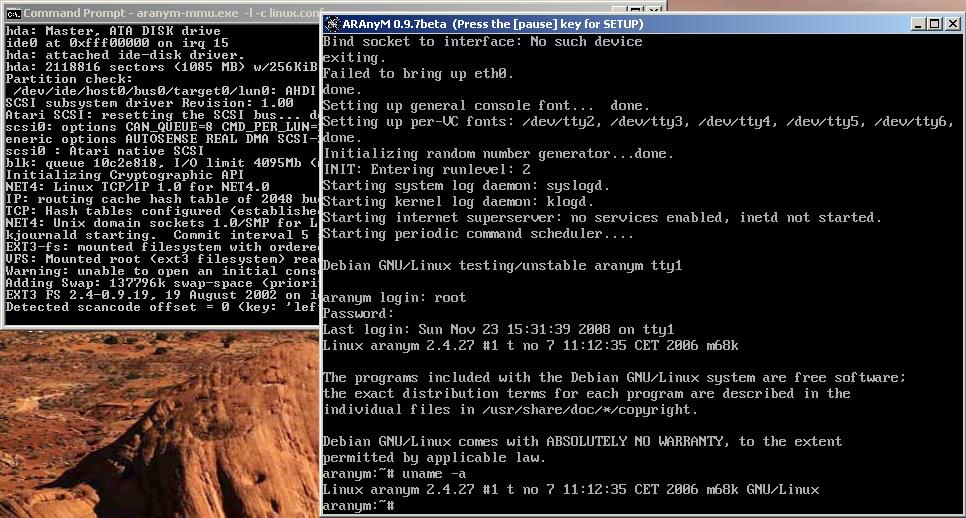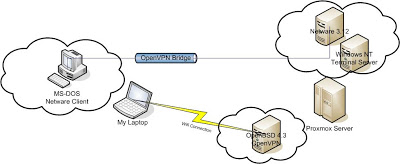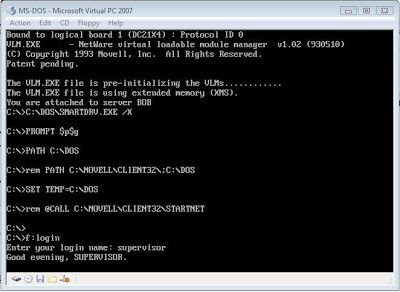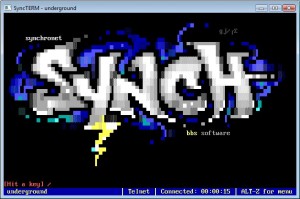Yearly Archives: 2008
Aranym, Atari 68040/mmu emulator!
Both a windows version and the source can be found here.
Now for the fun part!
You can download a patched kernel here that supports the virtual Ethernet, or just run a stock kernel (no networking though!)
Next you’ll want some kind of root filesystem, I would recommend the ‘etch’ disk which can be downloaded here.
Naturally, you’ll need a config, here is what I’m using..
—8<——8<——8<—
FastRAM = 256
Floppy =
TOS =
EmuTOS =
AutoGrabMouse = No
[LILO]
Kernel = ./vmlinux
Args = root=/dev/hda1 video=atafb:vga16 stram_swap=0
debug=par
Ramdisk =
[ETH0]
Type = bridge
Tunnel = tap0
[STARTUP]
GrabMouse = No Debugger = No
[IDE0]
Present = Yes
IsCDROM = No
ByteSwap = No
ReadOnly = No
Path = etch.img
Cylinders = 2102
Heads = 16 SectorsPerTrack = 63
ModelName = Master
—8<——8<——8<—
Then finally run it like this:
aranym-mmu.exe -l -c linux.conf
I’ll have to play some with the networking to get it going, it seemed straight forward the FAQ here, however I had no luck.
Anyways, it’s no A/UX, but it’s a *NIX like thing on the m68k. Now we just have to beg the Mac people to flesh out the hardware on their emulators to support Linux, OpenBSD, NetBSD & A/UX….
Proxmox VE hits the 1.0!
Proxmox – VE has hit the 1.0 today! Without fail, I’d say this is the best combination of full system emulation, and logical partitioning available as of today. I have been playing with Xen on Solaris 10, and frankly it SHOULD have been better, but it’s been so much worse.
Although Solaris Zones, coupled with ZFS & Xen should be a clear winner, you’ll find out real quick that Zones do *NOT* easily allow for independant tcp/ip stacks (hope you have v3 nic drivers), the Xen networking again is a mess (v3 drivers anyone? Also those interfaces better be TCP/IP enabled on the host!) and get ready to edit the /var/lib/xend/domains directory files a LOT…. And be ready for gegrep fun. Afterall domain names like “0aa811ef-3bd0-9140-583f-d5e09f93658e” make life all the easier. I will say that Xen does use Qemu disk images so there is an easy ‘upgrade’ path to/from KVM (the linux hypervisor found in ProxmoxVE). What I don’t get is the massive disconnect between virsh & the xend process.
And if you are running Xen, the you’ll want SOME print documentation… I just wish I didn’t think it’d be that intuitive. So at least creating this:
(device
(vif
(bridge iprb0)
(uuid c0e47a99-70e5-1ebe-44a4-54895cb24a15)
(script vif-vnic)
(mac 00:16:3e:56:df:81)
(model ne2k_pci)
(backend 0)
)
)
would have been easier.
From my notes, how to tell if your nic is new enough to drive Xen/Zones:
/usr/lib/vna NIC MAC
bash-3.2# /usr/lib/vna e1000g0 0:2:a5:4c:76:74
vnic5
If you don’t get something similar, you are screwed. Additionally this guide is invaluable as it’ll be your ONLY quick guide on how to get around xen on Solaris 10.
Anyways enough Xen bashing for now, but I have to say I’m excited about going back to ProxMox VE. Just remember to leave your base OS alone…. like a mainframe.
Fun with Qemu & Large Disks….
I was playing around with NeXTSTEP under a snapshot of qemu and I noticed that my arrow keys were not working correctly. After a few hours of digging about I found the fix was easy enough:
-k en-us
That’s it, just append that to your boot string, and away you go! Another annoyance has been my quest to install AROS onto a P4 computer.. I picked up a new 320GB IDE disk (WD Caviar Blue) .. which the BIOS & AROS promptly refused to acknowledge corectly. Everything was going to hell until I gave up and read the manual. Once again it was simple, there is a jumper setting for ‘older’ OS’s to see only 32gb, and naturally the BIOS is now happier. If only I could say the same of AROS…
OpenBSD 4.4 on VirtualPC 2007
Well it’s about that time, and OpenBSD has now just released version 4.4!
I’m a big fan of OpenBSD, and of course I wanted to load it up on my laptop. I’ve been wanting to do some tests with Quake1 so I have setup a test server, and now I was needing a client, so I figured OpenBSD should be able to do this.
I installed OpenBSD 4.4, ran ‘startx‘ and naturally had a completely deformed screen.
I did find out that manually running ‘xorgconfig‘ and setting up the wsmouse (protocol & port!), and then selecting the S3 driver “** S3 (not ViRGE or Savage) (generic) [s3]” Option number 25 I think… Anyways from there I told it to use 800×600 16bit depth, and now I’m able to use X11 no worries!
Some fun networking with MS-DOS & Novell Netware.
Ok I wanted to do this eventually but now I’ve finally done it. I have constructed something a little complex but it works surprisingly well.
Let me draw a picture so it’ll be a little easier to follow:
All of the machines in clouds are virtual…
Ok I’m going to assume you can install & configure OpenVPN on your own. I did a really simple install on Proxmox VE, just be sure to use the e1000 network adapters. All the others gave me tones of errors with any sizable traffic. Also I should point out that I’m using OpenBSD 4.3 which is the latest as of today.
dev tun0
dev-type tap
ca /etc/openvpn/ca.crt
cert /etc/openvpn/server.crt
dh /etc/openvpn/dh1024.pem
key /etc/openvpn/server.key
server-bridge 192.168.6.33 255.255.255.224 192.168.6.50 192.168.6.62
push “route 192.168.6.0 255.255.255.0”
push “dhcp-option DNS 192.168.6.34”
client-to-client
duplicate-cn
keepalive 10 120
max-clients 100
persist-key
persist-tun
status /var/log/openvpn-status.log
verb 3
tun-mtu 1500
fragment 1300
mssfix
float
Again I just followed the example from the OpenVPN site to set this up. What makes this different though is the fact that I’m using this in a bridge mode. As you can see I have told OpenVPN that it is to use the tun0 interface as a ‘tap’ driver.
My hostname.tun0 is this:
Link0 up
Likewise the bridgename.bridge0 is:
add em1
add tun0
up
And finally for this example my bridgename.em1 is:
inet 192.168.6.33 255.255.255.224 NONE
So using this setup I have a ‘private’ 192.168.6.32/27 network in which I’ve got a few virtual machines running and space for my laptop to VPN into. Now one of the virtual servers on my Proxmox server is Windows NT 4.0 Terminal Server… Yeah I know I got it cheap on ebay, and I kind of like it. Anyways I’m running Qemu on it, which is running Netware 3.12. I installed the libpcap then I had to find out what my Ethernet devices are called. I used wireshark (it was ethereal) and it’s a cool program to have around. The last version to run under Windows NT 4.0 was 0.99.4 so that’s the one I used. Once I have done this I found my device and was able to setup a string for Qemu (which was \Device\NPF_RTL80291)
Here is what I’m using:
Qemu –had netware.disk –m 16 –M isapc –L pc-bios –net nic –net pcap,devicename=â€\Device\NPF_RTL80291â€
This sets up an ISA computer with 16 megaybtes of ram and a single ISA nic that will utilize libpcap to send out frames on the rtl80291 that’s being emulated to my NT terminal server by proxmox.
On the ‘client’ side of things, I’m running the 64 bit version of Vista. So I’ve installed the OpenVPN that not only has 64 bit device drivers, but has a nice little GUI to connect & disconnect from the networks. Here is the OpenVPN config that is on my laptop.
dev tap
ca ca.crt
cert client1.crt
key client1.key
client
proto udp
remote 192.168.1.75 1194
resolv-retry infinite
nobind
persist-key
persist-tun
;comp-lzo
mssfix
tun-mtu 1500
fragment 1300
Ok, so far so good. Now I do have Virtual PC 2007 on my laptop, and I have made sure that the “Virtual Machine Network Services†were bound to the “TAP-Win32 Adapter V9†interface.
The it’s a simple matter of connecting to the VPN, then loading up the virtual PC with MS-DOS & the Novell Netware client.
Then you should be able to ‘bind’ to the server & login!
The ‘cool’ thing about this setup is that it will work over things like wifi, and easily allow you to add clients near & far. Oh and the best part for the wifi crowd is that it will use REAL encryption since WEP/WPA have all been shown to be useless. Oh yes, and it should allow you to host your DOOM, Quake 1, Rise of the Triad, Warcraft II, and Descent games…. Along with people playing at home! Using this you too can build your own IPX/Internet network!
I do hope this clears some of the uses & versility of Virtual servers, Qemu & Virtual Networking.
Netware 3.12 with Qemu
Ok I’m getting more requests on this which means I’ll finally do it.. I didn’t mean to put it off THIS long, honestly!
I have issues with Qemu 0.91 under Vista so this will all be with Qemu 0.90.
I have built a version with the libpcap compiled in, and placed a copy of the winpcap that I’m using in with this zip.
You can download the libpcap enable Qemu for Win32 right HERE.
I’m using the enclosed 1.cmd to run the thing, and I’ll go over more of it tomorrow.
Synchronet / Synchterm BBS fun!
You too can download your very own BBS software here.
There is even a GREAT terminal emulator suitably named Syncterm that completes the experence. It supports rsh, telnet, ssh, x/y/z modem and cool ANSI graphics!
Proxmox VE
Well frankly I’ve been majorly disappointed with Microsoft’s latest offerings in the world of virtualization. Frankly it’s been one BIG step backwards in terms of management.
I mean check this well meaning blog on how “easy” it is to setup remote management. And of course for the most part it NEVER works.
I know this must be a major news flash to Microsoft but you see virtual servers are like mainframes. The zone 0 OS must be able to stand on it’s own, and have just enough to bootstrap the hypervisor and allow itself to be managed in a stand alone fashion. After all if it were in a domain, where do you think those domain controllers are? Yep they are Virtual machines! And how do you ‘manage’ a domain resource with no DC’s? The whole 2008 Hyper-V is a BIG miscalculation on Microsoft’s part. I hope they wake up and notice how they had a good thing and have destroyed it.
All this nonsense sent me searching for an alternative which I’m pretty sure I found a great blend of system emulation, and something like SUN containers for Linux. There is even a Debian etch based quick install version called Proxmox which incorporates KVM (The new Linux hypervisor) and OpenVZ. And of course it’s FREE!
The cool thing is that the main management works on a web page, the consoles can be controlled via a VNC viewer that uses JAVA, and it’s VERY quick to setup.
The system emulation KVM uses the core devices from Qemu so a lot of Qemu virtual machines will “just work” if you copy them over. If you are installing an OS onto the virtual machine the ‘easy’ way is with the physical CD, you can use ISO images, however they are awkard to use. You have to flag the VM to pause on startup switch over to the monitor page and issue the following command:
change ide1-cd0 /directory/isoimage.iso
then tell the emulator to start up with the ‘c’ command which will continue from the pause…. Yeah I know it’s not terribly eligant.
On the OpenVZ front, it’s FAST as there is no real emulated IO it’s native. So I decided to use the wiki template and setup a wikipedia mirror at home. If anyone feels as brave you too can find instructions here:
These are some of the table times to load:
601M pages.sql Query OK, 7,473,186 rows affected, 8 warnings (5 min 10.52 sec)
837M revision.sql Query OK, 7,473,200 rows affected, 65535 warnings (2 min 11.84 sec)
18G text.sql Query OK, 7,473,202 rows affected, 1 warning (12 min 12.07 sec)
20M category.txt Query OK, 471,207 rows affected (13.14 sec)
1.8G categorylinks Query OK, 24,501,837 rows affected, 30177 warnings (28 min 28.31 sec)
5.6G externallinks Query OK, 36,492,925 rows affected (3 min 50.34 sec)
362M latestimage Query OK, 807,906 rows affected, 2 warnings (34.35 sec)
555M imagelinks Query OK, 18,615,721 rows affected (10 min 49.60 sec)
32k interwiki Query OK, 651 rows affected (0.08 sec)
186M langlinks Query OK, 5,780,509 rows affected (2 min 17.75 sec)
2G logging Query OK, 16,398,421 rows affected (2 min 51.75 sec)
45M oldimage Query OK, 118,449 rows affected (1.97 sec)
7.6G pagelinks Query OK, 270,641,297 rows affected (6 hours 12 min 4.83 sec)
104M redirect Query OK, 3,234,481 rows affected (23.71 sec)
1.2G template-link Query OK, 48,885,222 rows affected (50 min 7.08 sec)
68k user_groups Query OK, 3,947 rows affected (0.11 sec)
Even the ‘longest’ part here with the 270 million records took six hours… Not too bad! That’s still 12,122.88 TPS!
Also as a tip for anyone else crazy enough to do a sizable mediawiki (like wikipedia) or any single server wiki look to this page.
The upshot is that by loading this APC
extension into PHP and mediawiki load times for my cached site went from 2-5 minutes to 1-10 seconds.
The OpenVZ portion has various application templates that can be loaded into the zones from CentOS, Debian, Ubuntu, to pre configured applications like the media wiki and a few others.
If anything I’d say that proxmox is what I was hoping Microsoft’s Hyper-V could have been. A container version of windows with easy remote admin along with some system emulation could have made things MASSIVLY easier to deal with. It’s a shame they decided to go with this bizarre WMI based thing.
Hyper-V with Windows 2008 core
So I got a new Acer 5800 pc… CHEAP.. A quad core cpu, 4 gigs of ram and 600+ GB of diskspace for slightly over $500 CDN. Talk about POWER on the cheap!
So I wanted to load up the new Microsoft Hyper-V stuff, and check out the new “core” windows.
First this core thing is weird… And not very intuitive. I hope you are good with netsh!
Also, loading device drivers was a MAJOR pain. Let me say loading the marvel lan drivers was really strange until I came acrosss something about pnputil.
It would have been nice to have some kind of pop up help guild along with the CLI window so that us n00bs could have at least a guide as to what the hell is going on in server core.
Anyways for me the fun was:
pnputil -i -a yk60x64.inf
Then it worked like a champ. I know as time goes on, people will need this little tidbit on how to load device drivers on Windows 2008 core server. So I thought I’d put it out there.
Needless to say, i’m on the road, so I don’t have access to my Netware 3.12 CD, nor my Qemu VM so I can’t get into some kind of networking with Qemu thing like I want to. But I’ll do so soon. Honestly!
From what I hear about this Hyper-V is that it’s faster, and more feature filled then the prior versions of Virtual Server… I’ll have to see as now I’m loading the network drivers….
Oh, and another thing, is that all the services are IPv6 native, and Windows 2008 server, like Vista defaults to IPv6 then fails to IPv4. It seems like a good time for some 6to4 guides, or new DSL/WAP’ that do the 6to4 dance.





